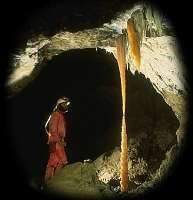 | ||
Solutional cave
A solutional cave or karst cave is a cave usually formed in the soluble rock limestone. It is the most frequently occurring type of cave. It can also form in other rocks, including chalk, dolomite, marble, salt beds, and gypsum.
Contents
- Solutional cave
- Solutional cave escape walkthrough
- Process
- Limestone caves
- Carbonic acid dissolution
- Hydrogen sulfide dissolution
- References
Solutional cave escape walkthrough
Process
Bedrock is dissolved by natural acid in groundwater that seeps through bedding-planes, faults, joints and so on. Over geological epochs these openings expand as the walls are dissolved to become caves or cave systems.
The portions of a solutional cave that are below the water table or the local level of the groundwater will be flooded.
Limestone caves
The largest and most abundant solutional caves are located in limestone. Limestone caves are often adorned with calcium carbonate formations produced through slow precipitation. These include flowstones, stalactites, stalagmites, helictites, soda straws, calcite rafts and columns. These secondary mineral deposits in caves are called speleothems.
Carbonic acid dissolution
Limestone dissolves under the action of rainwater and groundwater charged with H2CO3 (carbonic acid) and naturally occurring organic acids. The dissolution process produces a distinctive landform known as karst, characterized by sinkholes, and underground drainage. Solutional caves in this landform—topography are often called karst caves.
Hydrogen sulfide dissolution
Lechuguilla Cave in New Mexico is generally considered the world's most spectacularly decorated cave. Lechuguilla and nearby Carlsbad Cavern are now believed to be examples of another type of solutional cave. They were formed by H2S (hydrogen sulfide) gas rising from below, where reservoirs of oil give off sulfurous fumes. This gas mixes with ground water and forms H2SO4 (sulfuric acid). The acid then dissolves the limestone from below, rather than from above, by acidic water percolating from the surface.
